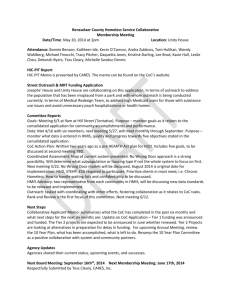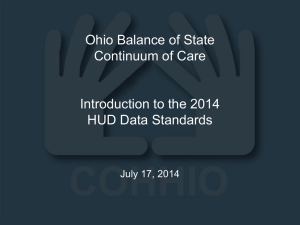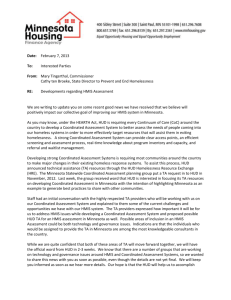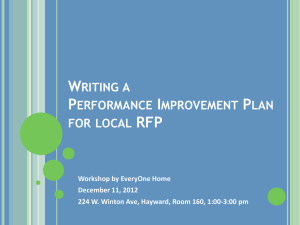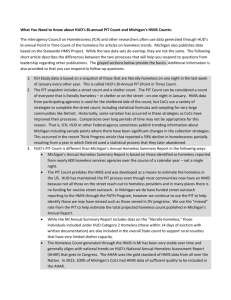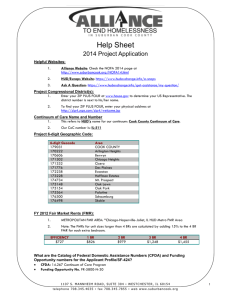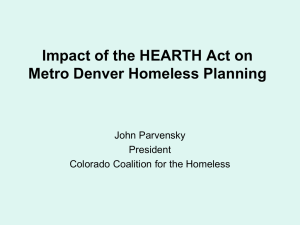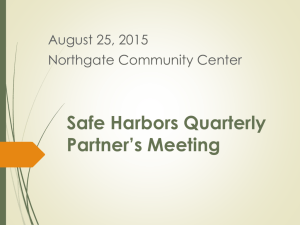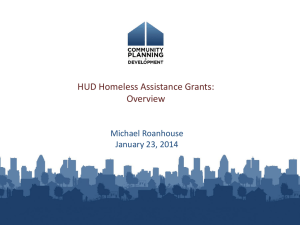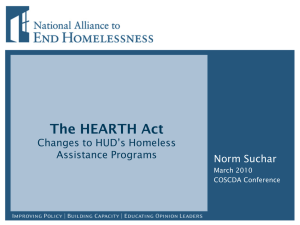Tips and Tools for Homeless Programs Data Collection
advertisement
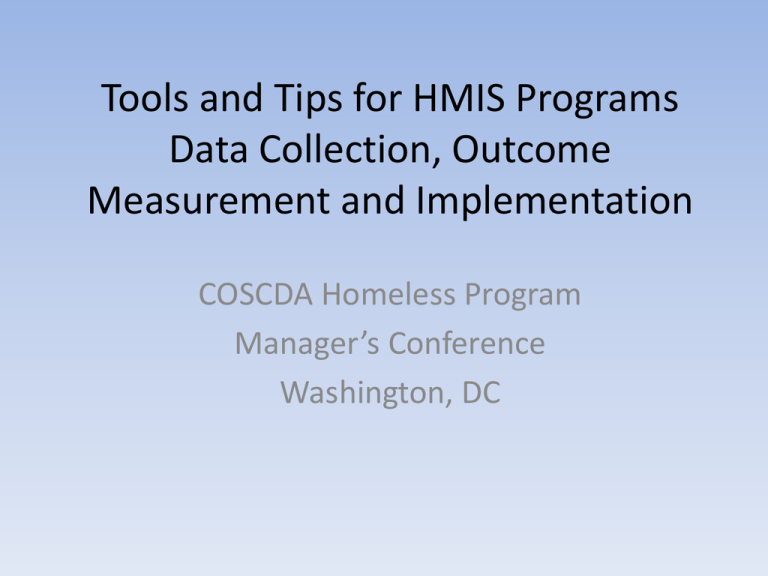
Tools and Tips for HMIS Programs Data Collection, Outcome Measurement and Implementation COSCDA Homeless Program Manager’s Conference Washington, DC HUD PERSPECTIVE JULIE HOVDEN Program Analyst Office of Special Needs Assistance Programs Dept. of Housing & Urban Development What’s Coming at HUD? • Revised Data Collection and Reporting – Revised HMIS Data Standards (data elements) • Updated XML schema – April 2010 – Annual Performance Report (APR) for CoC programs and HPRP – Annual Homeless Assessment Report (AHAR) – Homelessness Pulse Reports – Homeless Data Exchange (HDX) • Standardizing Federal Data & Reporting – Street Outreach programs • HEARTH Act and HMIS Revised Annual Performance Report • Name change: focus on performance • Some questions based on program type • Sections: – Project information – Program Outputs – Client Characteristics – Program Performance (outcomes) • Electronic submission in e-snaps APR Transition Period • Beginning May/June 2010 all APRs will be submitted in e-snaps (no HUD 40118 form) • Projects with operating years ending April 30, 2010 and earlier will submit HUD 40118 form. • Projects with operating years ending after April 30th will submit in e-snaps based on data collected in 2009-10 operating year – Some questions are different – New questions are optional for transition period APR Transition Period (cont.) • Some changes: – Age categories – Universe of persons for some elements – New street outreach questions – New HMIS project questions • Guidance on completing APRs during transition year will be published in April/May • Submit questions to Virtual Help Desk on HUD HRE (www.hudhre.info) Annual Homeless Assessment Report (AHAR) • Four table shells – ES for individuals; ES for families – TH for individuals ; TH for families • CoCs submit data for 1 to 4 table shells • Minimum bed coverage required for participation • Data from HMIS (table shells), HIC and PIT counts. • Supplemental reports AHAR PARTICIPATION HISTORY 450 # of CoCs 400 350 2009 300 335 250 2008 200 222 150 100 50 0 2007 2005 2006 97 64 74 AHAR • 2009 AHAR » June 2010 – ES and TH programs – Supplemental Report on Veterans • 2010 AHAR » June 2011 – Data collected in HMIS: 10/1/09=9/30/10 – Data reported: October – November 2010 – PH programs added (= 6 tables shells) – Supplemental Report on Veterans Homelessness Pulse Reports • Intended to help HUD better understand impact of economic crisis on homelessness • Quarterly reporting – Started in 2009 (1st quarter CY09) – HMIS data on sheltered persons only – Newly homeless persons Pulse Reports • Currently limited to following CoCs: o Phoenix/Mesa/Maricopa County, AZ o Bridgeport, Stratford and Fairfield, CT o District of Columbia o Lakeland/Winterhaven/ Polk County, FL o Shreveport/Bossier/ Northwest, LA o New York City, NY o Cleveland/Cuyahoga County, OH o Richmond/Henrico, Chesterfield and Hanover Counties, VA • Once OMB approves data collection, more CoCs will be allowed to participate Homelessness Data Exchange • HDX is expansion of AHAR Exchange • CoCs will submit data electronically for: – AHAR – Homelessness Pulse Reports – Housing Inventory Count (HIC) – Point in Time Count (PIT) • HDX to go live in May 2010 Standardizing Federal Data & Reporting • December 2009: Agreement between HHS and HUD for data collection and reporting for street outreach programs funded by PATH and/or SHP. • HUD awaiting OMB approval. • HHS to initiate OMB/PRA process. Street Outreach Outputs • Contacts and Engagements – # of persons contacted and # of times contacted – # of persons engaged after various # of contacts – Living situation at time of first contact • Persons identified as sleeping in places not meant for human habitation • Persons identified as sleeping in a shelter/ housing service site or other form of housing • Persons whose living arrangements are unknown Street Outreach Outcomes • Housing stability • Service linkage (select at least one) – Physical Disability – Developmental Disability – Chronic Health – HIV/AIDS – Mental Health – Substance Abuse HEARTH Act • Allows CoC to apply as a Collaborative Applicant (similar to current process) or Unified Funding Agency • Consolidates 3 current CoC programs (SHP, S+C, SRO) into 1 CoC program • Creates new Rural Housing Stability Program • Revises ESG to Emergency Solutions Program with increased funding and eligible activities – Increased focus on prevention and rapid re-housing HEARTH and HMIS • Requires ESG and CoC grantees to use HMIS – State grantees may have to implement data warehouse • No statewide HMIS • More than 1 CoC in the state • More than 1 HMIS software product used across the state – HMIS continues to be managed at CoC level – Client level data collected at CoC HMIS level by grantees and subgrantees RESOURCES • HUD Homelessness Resource Exchange (HRE) – Virtual Help Desk – Resource Library – Notices and NOFAs – Community Documents – HUD Guidance • Homeless, HMIS and CoC PoC listserv groups – Sign-up at www.hudhre.info or www.hud.gov COMMUNITY PERSPECTIVE JULIE EBERBACH Project Director Iowa Institute for Community Alliances The Essential Elements… • Effective Client Assessment – Evaluation of client progress is difficult without comprehensive entry assessment • Quality Data Collection – Data completeness – Collection of appropriate data elements – Accuracy Outcomes Measurement • HUD’s HPRP Outcomes – Reduction of time in shelter (length of stay) – Reduction of persons “entering” homelessness for the first time (more effective homeless prevention) – Increase the number of persons who are diverted from shelter – Reduce repeat episodes of homelessness (recidivism) – Reduce the overall number of homeless persons/families – Reported by: • Initial Performance Report (IPR) • Quarterly Performance Report (QPR) • Annual Performance Report (APR) • HUD’s SHP Outcomes – – – – 63.5% of persons exit to permanent housing from transitional housing 71.5% remain stably housed for over 6 months 19% of persons have employment income at exit Reported by: • Annual Progress Report (APR) Data Collection Elements • Program Entry Information • Client Demographics – Gender, age, race, veterans status, disability status • • • • Housing Status Income Data Services Provided Program Exit Information – Housing status, income, stability at exit Data Quality Tools • Regular and REQUIRED Data Quality Reports – Commencing Year Data Quality Certifications – Monthly Data Quality Report (for draw request period) – Year End Close Out Data Detail Certifications – Monthly “All Stars” Report – HPRP Monthly Data Quality Report and QPR Certification – AHAR Report Certifications – Point In Time Report/HIC Certifications Client Assessment Tools • • • • Housing Barriers Assessment Client Intake Information Self Sufficiency Matrix Vulnerabilities Index Housing Barriers Assessments • Developed in Minnesota • Used extensively in Georgia • Designed to direct clients to the “right” program • Three Focus areas – Tenant Issues – Personal Issues – Income Issues Self Sufficiency Matrix • Developed in Arizona • Used as a program evaluation tool • Becoming a Client centered Outcome measurement tool. • 17 Domain Areas • Assessment re-taken over time to reflect progress Domain Score 1 2 3 4 5 Income no income Inadequate income and/or spontaneous or inappropriate spending Can meet basic needs with subsidy; appropriate spending Can meet basic needs and manage debt without assistance Income is sufficient, well managed; has discretionary income and benefits Employment No job Temporary, part-time or seasonal; inadequate pay, no benefits. Employed full time; inadequate pay; few or not benefits Employee full time with adequate subsidized housing. Maintains permanent employment with adequate income and benefits. Housing Homeless or threatened with eviction In transitional, temporary or substandard housing; and/or current rent/mortgage payment is unaffordable (over 30%of income) In stable housing that is safe but only marginally adequate. Household is in safe, adequate, subsidized housing. Household is safe, adequate, unsubsidized housing. Food No food or means to prepare it. Relies to a significant degree on other sources of free or low-cost food. Household is on food stamps Can meet basic food needs, but requires occasional assistance. Can meet basic food needs without assistance. Can choose to purchase any food household desires. Childcare Needs childcare, but none is available/accessible and/or child is not eligible. Child case is unreliable or unaffordable, inadequate supervision is a problem for child care that is available Affordable subsidized childcare is available, but limited. Reliable, affordable childcare is available, no need for subsidies Able to select quality childcare of choice Safety Home or residence is not safe; immediate level of lethality is extremely high; possible CPS involvement Safety is threatened/temporary protection is available; level of lethality is high Safety is threatened/temporary protection is available; level of lethality is high Safety is threatened/temporary protection is available; level of lethality is high Safety is threatened/temporary protection is available; level of lethality is high Parenting Skills There are safety concerns regarding parenting skills There are safety concerns regarding parenting skills There are safety concerns regarding parenting skills There are safety concerns regarding parenting skills There are safety concerns regarding parenting skills Children's Education One or more eligible children not enrolled in school. One or more eligible children enrolled in school, but not attending classes. Enrolled in school, but one or more children only occasionally attending classes. Enrolled in school and attending classes most of the time. All eligible children enrolled and attending on a regular basis Adult Education Literacy problems and/or no high school diploma/GED are serious barriers to employment. Enrolled In literacy and/or GED program and/or has sufficient command of English to where language is not a barrier to employment. Has high school diploma/GED Needs additional education/training to improve employment situation and/or resolve literacy problems to where they are able to function effectively in society. Has completed educational/training needed to become employable. No literacy problems Legal Current outstanding tickets or warrants. Current charges/trial pending, noncompliance with probation/parole. Fully compliant wit probation/parole terms. Has successfully completed probation/parole within past 12 months, no new charges filed. No active criminal justice involvement in more than 12 months and/or no felony criminal history Health Care No medical coverage with immediate need. No medical coverage and great difficulty accessing medical care when needed. Some household members may be in poor health. Some members (eg Children on AHCCCS All members can get medical care when needed, but may strain budget. All members are covered by affordable, adequate health insurance. Life Skills Unable to meet basic needs such as hygiene, food, activities of daily living. Can meet a few but not all needs of daily living without assistance. Can meet most but not all daily living needs without assistance. Able to meet all basic needs of daily living without assistance Able to provide beyond basic needs of daily living for self and family. Mental Health Danger to self or others; recurring suicidal ideation; experiencing severe difficulty in day-today life due to psychological problems. Recurrent mental health symptoms that may affect behavior, but not a danger o self/others; persistent problems with functioning due to mental health symptoms. Mild symptoms may be present but are transient; only moderate difficulty in functioning due to mental health problems. Minimal symptoms that are expectable response to life stressors; only slight impairment in functioning Symptoms are absent or rare; good or superior functioning in wide range of activities; no more than every day problems or concerns. Vulnerability Index • A tool for identifying and prioritizing the street homeless population for housing according to the fragility of their health. • Survey instrument administered on the streets. • Creation of a “real” list of all the people on the streets. Vulnerability Index For individuals who have been homeless for at least six months, one or more of the following markers place them at heightened risk of mortality: 1) more than three hospitalizations or emergency room visits in a year 2) more than three emergency room visits in the previous three months 3) aged 60 or older 4) cirrhosis of the liver 5) end-stage renal disease 6) history of frostbite, immersion foot, or hypothermia 7) HIV+/AIDS 8) tri-morbidity: co-occurring psychiatric, substance abuse, and chronic medical condition Tools Built into I-COUNT • • • • • HPRP Required Reports SHP Required Reports ESGP Required Reports (Iowa HAP Grant App) Self Sufficiency Matrix Customized reporting for local needs Additional Informational Resources HUD’s Homeless Resource Exchange www.hudhre.info National Human Services Data Consortium www.nhsdc.org National Alliance to End Homelessness www.endhomelessness.org Questions? Iowa Institute for Community Alliances www.iowainstitute.net 515-246-6643 Julie Eberbach, Project Director julie@iowainstitute.net Thank You! COMMUNITY PERSPECTIVE JONATHAN HARDY Director, State Community Services Office Utah Department of Community and Culture
